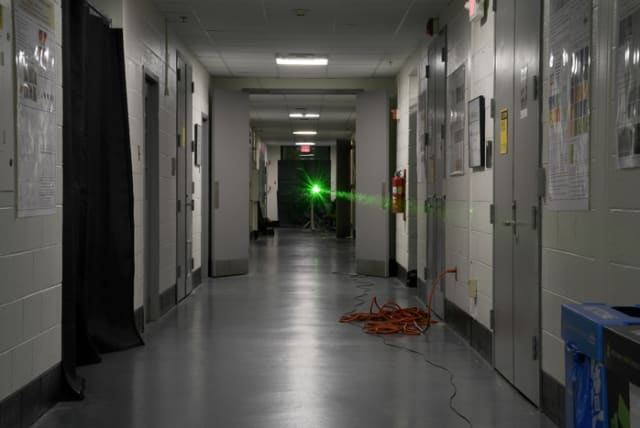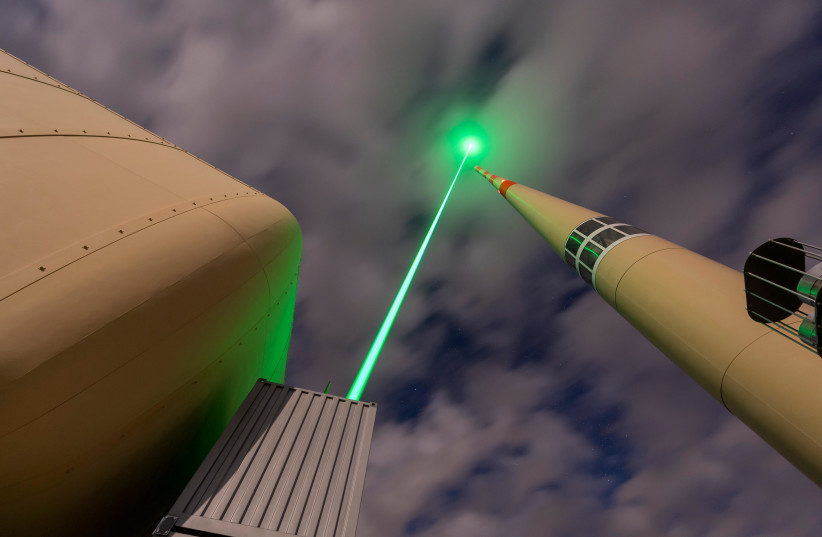Laser experiment breaks record crossing University of Maryland hallway

The experiment, which made a hole in the wall and fired the laser into the 50-meter long hallway, set a new record
Physicists at the University of Maryland set a new record recently with a nearly 50-meter laser experiment.
The team set out to investigate “optical guiding”: a method of directing light through air, which could be used for long-range laser communication.
Based on a 2014 study, they knew that this works over distances smaller than a meter, but they couldn’t expand their reach because their lab was too small, and the highly powerful laser they used couldn’t be easily transported.
Their solution? Make a hole in the wall and fire the laser into the 50-meter-long hallway. In a paper, accepted for publication in the journal Physical Review X,the scientists noted how they set a record by guiding light in 45-meter-long air waveguides and explained the physics behind their method.
Without fiber optic cables or waveguides, a light beam—whether from a laser or a flashlight—will continuously expand as it travels, according to the UMD team. If allowed to spread unchecked, a beam’s intensity can drop to un-useful levels. Whether you are trying to recreate a science fiction laser blaster or to detect pollutant levels in the atmosphere by pumping them full of energy with a laser and capturing the released light, it pays to ensure efficient, concentrated delivery of the light.
“There were major challenges: the huge scale-up to 50 meters forced us to reconsider the fundamental physics of air waveguide generation, plus wanting to send a high-power laser down a 50-meter-long public hallway naturally triggers major safety issues,” says Professor Howard Milchberg, a physicist at the University of Maryland. “Fortunately, we got excellent cooperation from both the Physics (Department) and from the Maryland environmental safety office!”
A dangerous study
Researchers said the laser is powerful enough to burn paper and skin. Therefore, the team did their work at night, so they could block off the corridor with minimal inconvenience to their co-inhabitants.
They showed that the technique could extend the length of the air waveguide, increasing the power they could deliver to a target at the end of the hallway. At the conclusion of the laser’s journey, the waveguide had kept about 20% of the light that otherwise would have been lost from their target area, according to the study. The distance was about 60 times farther than their record from previous experiments.
After several nights of testing, the researchers found their waveguide technique could conserve roughly 20% of the light that would normally be dissipated through the air. With more testing, they believe they can make the guide more efficient.
“If we had a longer hallway, our results show that we could have adjusted the laser for a longer waveguide,” says Andrew Tartaro, a UMD physics graduate student who worked on the project and is an author on the paper. “But we got our guide right for the hallway we have.”
The team concluded that they are not yet near the theoretical limit of the technique, and Milchberg said they hope to expand the research.
“Based on new lasers we are soon to get, we have the recipe to extend our guides to one kilometer and beyond,” he said.
Jerusalem Post Store
`; document.getElementById("linkPremium").innerHTML = cont; var divWithLink = document.getElementById("premium-link"); if (divWithLink !== null && divWithLink !== 'undefined') { divWithLink.style.border = "solid 1px #cb0f3e"; divWithLink.style.textAlign = "center"; divWithLink.style.marginBottom = "15px"; divWithLink.style.marginTop = "15px"; divWithLink.style.width = "100%"; divWithLink.style.backgroundColor = "#122952"; divWithLink.style.color = "#ffffff"; divWithLink.style.lineHeight = "1.5"; } } (function (v, i) { });

